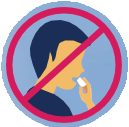Health & Safety
Home | Health & SafetyDry ice is extremely cold and turns directly into carbon dioxide gas — which means proper handling is essential for your safety and those around you. At Dry Ice Jeddah, we care about your safety as much as we care about providing quality dry ice.
Please follow these guidelines whenever handling or using dry ice:
 |
DRY ICE CHANGES TO GASEOUS CARBON DIOXIDE, WHICH CAN RAPIDLY ASPHYXIATE WITHOUT WARNING. |
 |
STORE AND USE DRY ICE IN WELL-VENTILATED AREAS TO PREVENT CARBON DIOXIDE ACCUMULATION. |
 |
USE EXTREME CAUTION WHEN TRANSPORTING IN A PASSENGER VEHICLE. |
 |
NEVER PLACE DRY ICE IN YOUR MOUTH. |
 |
ENSURE PROPER DISPOSAL OF DRY ICE. |
 |
IF POSSIBLE, STORE IN A COOL AREA TO SLOW CONVERSION TO GAS AND MINIMIZE CARBON DIOXIDE VAPORS. |
 |
PLACE SIGNS AND USE CARBON DIOXIDE MONITORING AND VENTILATION IN AREAS WHERE CARBON DIOXIDE GAS CAN ACCUMULATE, PARTICULARLY IN LOW LYING OR ENCLOSED AREAS. |
 |
WEAR APPROPRIATE PERSONAL PROTECTIVE EQUIPMENT (PPE) |
 |
NEVER STORE IN AN AIR TIGHT CONTAINER |
 |
COMPANY WILL NOT BE RESPONSIBLE FOR ANY MISS HANDLING WITH DRY ICE BURN. |
 |
ALWAYS USE AND STORE IN A WELL-VENTILATED AREA |
 |
DRY ICE IS EXTREMELY COLD AND CAN FREEZE HUMAN TISSUE ON CONTACT. IF SWALLOWED, THE DRY ICE WILL RAPIDLY EXPAND AND CAN CAUSE SERIOUS INJURY OR DEATH. |
 |
DIRECT CONTACT WITH DRY ICE CAN CAUSE SEVERE FROSTBITE, SKIN LESIONS, BURNS, OR DEEP FREEZING OF TISSUE. ALWAYS USE PROTECTIVE GLOVES SUCH AS WORK GLOVES TO HANDLE DRY ICE. |
 |
AS DRY ICE SUBLIMATES (CONVERTS TO CARBON DIOXIDE GAS), PRESSURE BUILD-UP CAN CAUSE AN AIR-TIGHT CONTAINER TO RUPTURE OR EXPLODE USE WELL INSULATED CONTAINERS DESIGNED TO PREVENT PRESSURE BUILD UP TO STORE DRY ICE. |
 |
IMPROPERLY DISPOSED DRY ICE CAN CREATE A HAZARDOUS ATMOSPHERE, CAN POSE THREATS TO HUMANS AND ANIMALS, AND CAN ATTRACT INSECTS. ALLOW DRY ICE TO EVAPORATE (SUBLIMATE) TO THE ATMOSPHERE IN A WELL-VENTILATED, SECURED AREA. |
 |
VEHICLE OCCUPANTS MAY BE OVERCOME BY CARBON DIOXIDE WITHOUT WARNING. IF TRANSPORTING IN THE PASSENGER COMPARTMENT OR TRUNK OF A VEHICLE, LIMIT DRY ICE TO SMALL QUANTITIES AND OPEN ALL WINDOWS OR ENSURE CONSTANT SUPPLY OF FRESH AIR FOR THE DURATION OF THE TRIP. |
In Case of Emergency
If someone touches dry ice and experiences skin damage, treat it like a burn:
-
Remove contact immediately
-
Soak the area in warm (not hot) water
-
Seek medical help if needed
If dizziness or breathing issues occur, move to fresh air immediately and seek medical attention if symptoms persist.
⚠️ 1. Use Protective Gloves
Dry ice is -78.5°C and can cause severe frostbite if it comes into direct contact with your skin.
Always wear insulated gloves, tongs, or a towel when handling dry ice.
Never touch dry ice with bare hands.
2. Ensure Proper Ventilation
As dry ice sublimates (melts), it turns into carbon dioxide gas, which can displace oxygen in a closed space.
Use dry ice in well-ventilated areas.
Never store or use it in small, airtight spaces like closets, cars, or walk-in fridges without ventilation.
Signs of CO₂ buildup include dizziness, headache, or shortness of breath.
3. Avoid Direct Inhalation
Although CO₂ gas is not toxic, breathing in large amounts can cause discomfort or suffocation.
Allow the gas to dissipate naturally.
Don’t lean directly over containers of dry ice or enclosed fog machines.